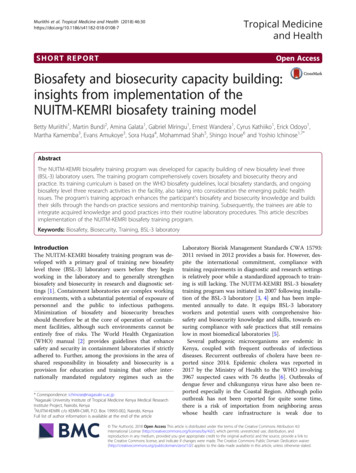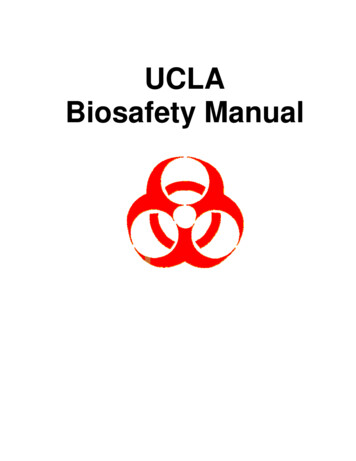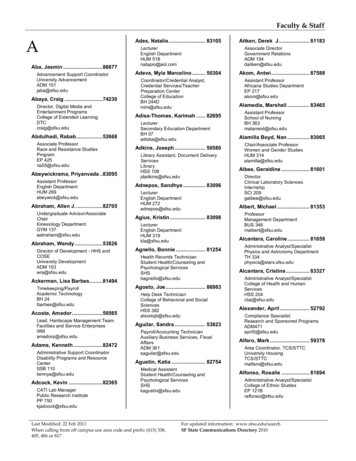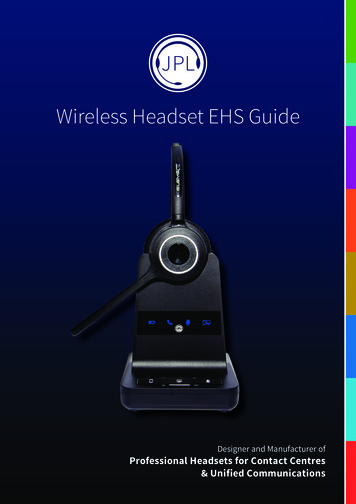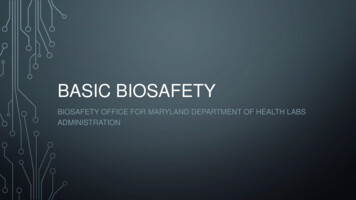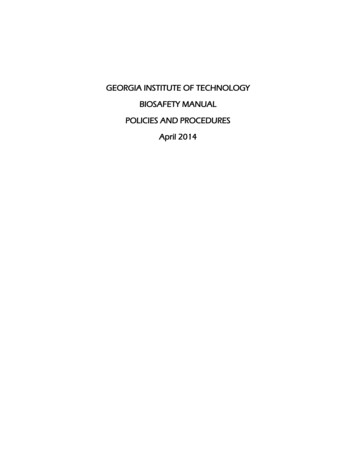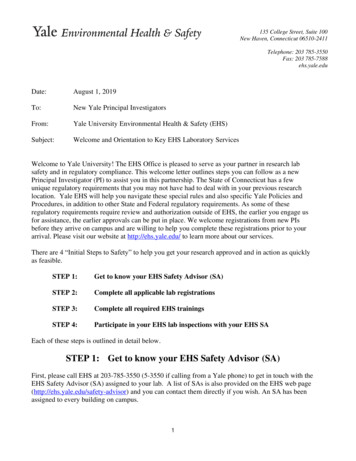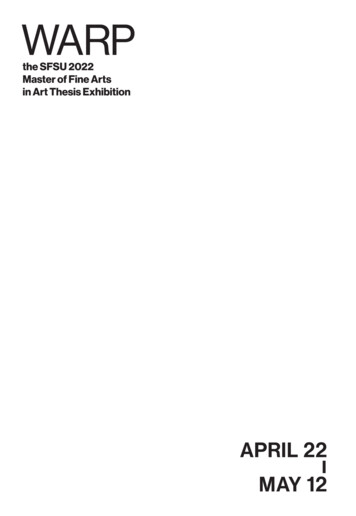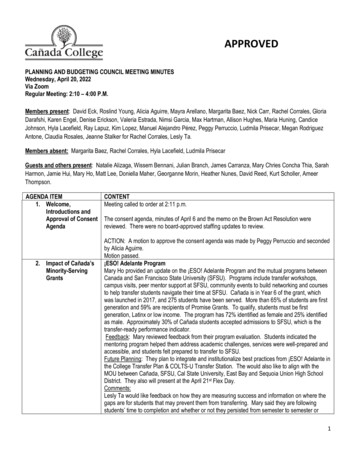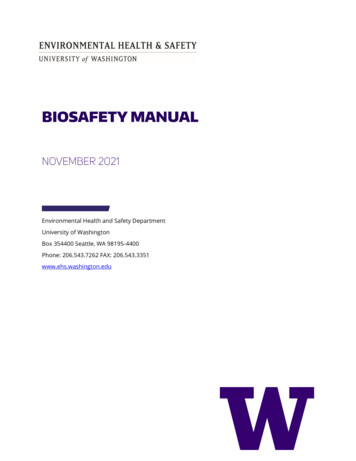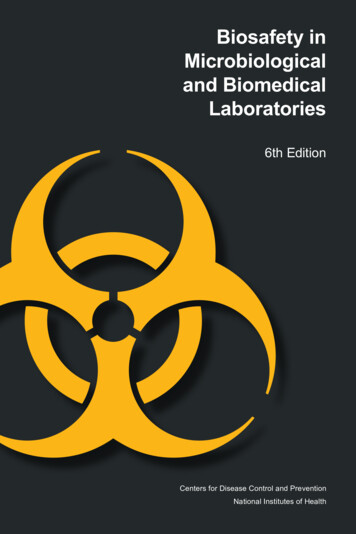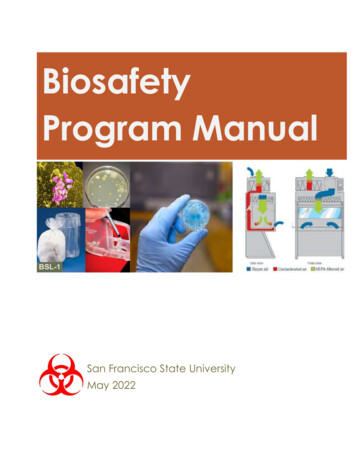
Transcription
BiosafetyProgram ManualSan Francisco State UniversityMay 2022
INTENTIONALLY LEFT BLANK
Table of ContentsBIOSAFETY P R O G R A M M A N U A L . ERROR! BOOKMARK NOT SAFETY PROGRAM .1SCOPE OF THE BIOSAFETY PROGRAM .1EXPECTATIONS .1PERSONNEL RESPONSIBILITIES .1UNIVERSITY BIOSAFETY COMMITTEE .2RECORDS .3EMPLOYEE TRAINING .3BIOHAZARDOUS WASTE .4BLOODBORNE PATHOGENS .4AEROSOL TRANSMISSIBLE DISEASES .4IMMUNE COMPETENCE AND SUSCEPTIBILITY .5BIOHAZARD USE AUTHORIZATIONS .6BIOLOGICAL RISK GROUPS .81.0BIOSAFETY LEVELS OF CONTAINMENT .82.03.04.05.0RECOMBINANT OR SYNTHETIC NUCLEIC ACID MOLECULES (RSNA) .10SELECT AGENTS .10ANIMAL SUBJECTS .11HUMAN SUBJECTS.11C.STANDARD MICROBIOLOGICAL PRACTICES .121.0 HYGIENE AND HOUSEKEEPING .122.0 PERSONAL PROTECTIVE EQUIPMENT (PPE) .123.0 SECURITY AND ACCESS .13D. BIOSAFETY LEVEL 2 CONTAINMENT PRACTICES .151.0 ACCESS.152.0 PERSONAL PROTECTION & CLOTHING .153.0 SIGNS AND LABELS .164.0 LABORATORY SPACE .165.0 CONTAMINATION AND EXPOSURE PREVENTION .166.0 DECONTAMINATION BASICS .177.0 SHARPS AND UNIVERSAL PRECAUTIONS .188.0 BIOHAZARDOUS MATERIALS SPILLS .18E.BIOLOGICAL WASTE.201.0 BASIC REQUIREMENTS .202.0 GENERAL PROGRAM RULES .203.0 LABELING BIOLOGICAL WASTE .21
4.05.06.07.08.09.010.011.012.013.0BIOLOGICAL WASTE CATEGORIES .21NON-HAZARDOUS BIOLOGICAL WASTE (BSL-1).22MEDICAL AND BIOHAZARDOUS WASTE STORAGE (BSL-2).23PATHOLOGY WASTE.24SHARPS WASTE.26CHEMICAL DISINFECTION .26STERILIZATION AT SFSU .27AUTOCLAVE USE POLICY .28REQUIREMENTS FOR AUTOCLAVING WASTE .28PROBLEMS WITH AUTOCLAVES .29APPENDIX A – REVIEW AND UPDATE LOG.31APPENDIX B – BIOLOGICAL WASTE DISPOSAL CHART .32APPENDIX C – AEROSOL TRANSMISSIBLE DISEASE PROGRAM - LAB.34ASSESSING RISK AND CONTROLS .34ATD EXPOSURE CONTROL/B IOSAFETY PLAN .34
San Francisco State UniversityUniversity Biosafety CommitteeBiosafety Program ManualRev. May 2022A. Biosafety ProgramSan Francisco State University (the University) has developed this Biosafety Program Manual(Manual) for researchers, staff, and laboratory instructors who work with biological materials. Itshould be used in conjunction with the Chemical Hygiene and Safety Plan, which coverschemical laboratory safety.1.0 Scope of the Biosafety ProgramThe Biosafety Program covers departments and facilities associated with the University,including the Romberg Tiburon Center and field station operations under the control of SFSU.The biosafety program described in this Manual covers biological work in the sciences.2.0 ExpectationsThis Manual serves as a blueprint for scientific work with biologicals, particularly those that arepathogenic to humans, plants, animals, or the environment.(1) SFSU personnel are required to follow the protocols established in this Biosafety ProgramManual and to register biological materials that are potentially biohazardous.(2) Faculty and staff are expected to follow established Standard Microbiological Practicesand to make sure safe work practices are carried out.(3) All biological wastes must either be disposed of using a licensed contractor or properlysterilized and packaged before placing in municipal trash bins. Certain liquid wastes maybe disinfected before disposal into the municipal sewer system using a bleach solution orother approved solution.(4) Personnel who work with biological materials must be trained in their potential hazardsand in appropriate protective measures as specified in this Manual.(5) Pregnant or immunocompromised people should consult with their personal physician toassess their risks. Special accommodation may be possible in certain situations. Contactcampus DPRC (Disability Programs and Resource Center) for more information. EmailPhone: 415.338.24723.0 Personnel ResponsibilitiesEach person working with biological materials in the sciences are responsible for following, at aminimum, the Standard Microbiological Practices listed in SECTION C, of this Manual.Page 1 of 29
San Francisco State UniversityUniversity Biosafety CommitteeBiosafety Program ManualRev. May 2022(1) The Principal Investigator is responsible for ensuring that all members of the laboratoryare familiar with safe research practices and to have appropriate personal protectiveequipment available.(2) Staff technicians, instructors, lab managers and others who provide supervisory roles inlaboratory settings are responsible for overseeing the safety practices in theirlaboratories and for reporting problems or accidents to the appropriate faculty memberor stockroom manager(3) Faculty and staff in supervisory roles are also responsible for ensuring compliance withother aspects of the Biosafety Program. Completing the Biohazard Use Authorization process when applicable to the materials tobe used Understanding the risk classification of their biological agents Storing and disposing of biological waste in accordance with Section E of this manual(4) Employees who work with biological materials are responsible for reading this manualand/or attending a training session by their supervisor and for carrying out the safetypractices outlined here.(5) Campus EH&S staff provides guidance, information, training, and review of biologicalsafety programs as needed.(6) Biosafety Committee is responsible for reviewing the use of restricted or pathogenicbiological materials.4.0 University Biosafety CommitteeSFSU has formed a Biosafety Committee (BSC) responsible for overseeing the use of biologicalmaterials in the sciences, especially the use of biohazardous materials or organisms.(1) The BSC is made up of at least two staff members and two faculty members and chairedby one of the faculty in the sciences.(2) The BSC will meet periodically to review biological materials applications and evaluateregulatory compliance as necessary(3) The use of the following categories of biological agents must be reviewed by the BSC US Patriot Act: Select Agents Recombinant DNA and RSNA work Pathogens of Risk Group 2 or above Some uses of Risk Group 1 biological materialsPage 2 of 29
San Francisco State UniversityUniversity Biosafety CommitteeBiosafety Program ManualRev. May 2022(4) Researchers and instructors who want to work with materials in the categories abovemust submit a “Biohazard Use Authorization” (BUA) application to the BSC before suchmaterials may be brought onto campus property.The University Biosafety Committee is not an Institutional Biosafety Committee (IBC) asdescribed by NIH (National Institutes of Health and CDC (Centers for Disease Control). Atthis time, all BSL-3, BSL-4, and most NIH “non-exempt” RSNA projects are not approvedfor use at SFSU. Exception: The BSC has approved the use of E. Coli B and W strain, whichis NIH non-exempt. In certain cases, non-exempt RSNA projects may be approved bythe ORSP Administration in consultation with the Biosafety Committee.5.0 RecordsRecordkeeping is an essential part of the SFSU Biosafety Program.(1) Autoclave records Department personnel who are responsible for autoclaves must ensure QC and use logsare maintained and retained for at least 3 years: Testing and maintenance logs Record use in log books each time waste is sterilized Autoclave training records(2) Training records Faculty and staff managers are responsible for keeping records of task/lab-specifictraining. Campus EH&S Staff keep records of Bloodborne Pathogen Training. Refresher training isdone online or via in-person classroom sessions. The Biology Dept manages user training for the Biology autoclaves used to treat waste.Annual refresher training is available online. Safety training records are typically kept for three years, unless otherwise specified.(3) Incident reportsLab managers are responsible for reporting incidents to the Campus EH&S Staff and fortaking steps to prevent recurrences. Incidents resulting in injuries requiring treatmentmust be reported to ERM-Worker’s Compensation group at 415.338.2565.6.0 Employee TrainingSafety training for new employees is mandated by Title 8, CCR 3203, Injury and IllnessPrevention Program and is the responsibility of the Principal Investigator or staff supervisor.Page 3 of 29
San Francisco State UniversityUniversity Biosafety CommitteeBiosafety Program ManualRev. May 2022(1) Train lab employees, including student volunteers, wherever biological organisms areused in good microbiological use practices.(2) Include training for specific tasks and equipment.(3) Document training in BSL-2 safe work practices for affected workers. A training course isavailable online.(4) Ensure that lab workers can show competence at their assigned tasks.(5) Review procedures when new organisms or materials are introduced.7.0 Biohazardous WasteThe Campus Environment, Health, and Safety department (“Campus EH&S”) oversees thecampus Medical Waste Management Plan (MWMP). BSL-2 biohazardous waste is “medicalwaste” per the California Medical Waste Management Act (MWMA) and is regulatedaccordingly. Section E of this Manual describes the requirements for storing, treating, anddisposing of biological waste.8.0 Bloodborne PathogensThe presence of bloodborne pathogens in the workplace is regulated by Title 8 CCR 5193,Bloodborne Pathogens Standard (BBP). This regulation applies medical clinics, teaching, andresearch laboratories working with blood and other materials that could contain humanpathogens, such as HIV.Note: Other employee groups such as uniformed police officers and custodians with occupationalexposure to human blood or other potentially infectious materials are also covered by the BBPStandard, but are beyond the scope of this program.Any use of human blood or unfixed tissue, or work with human pathogens falls under thecampus BBP Exposure Control Plan. The University Biosafety Committee (BSC) requires a BBPWork-specific Exposure Control Plan be submitted as part of the BUA application.9.0 Aerosol Transmissible DiseasesThe California Occupational Safety and Health Administration (Cal/OSHA) issued the AerosolTransmissible Diseases Standard to mitigate occupational exposures to pathogens transmittedvia aerosols and droplets. The regulations specify that employers must implement an effectiveprogram to minimize exposure of employees to aerosol transmitted diseases (ATD).At SF State, laboratory operations that use the following biohazardous materials are coveredby the ATD Standard.Page 4 of 29
San Francisco State UniversityUniversity Biosafety CommitteeBiosafety Program ManualRev. May 2022 Appendix D: Aerosol Transmissible Pathogens – Laboratory of the ATD Standard lists theorganisms subject to the ATD Standard.Principal investigators with research involving any of the agents listed in Appendix D, such asSalmonella spp, must understand and comply with the ATD Exposure Controls included as partof this Biosafety Manual as Appendix C.A separate section, § 5199.1 Aerosol Transmissible Diseases - Zoonotic), explicitly coversoperations involving the capture, sampling, or transportation of wildlife and operationsinvolving samples, cultures, or other materials potentially containing zoonotic aerosoltransmissible pathogens. A separate ATD Exposure Control Plan is available in the AnimalContact Occupational Health and Safety Program administered by EH&S and the IACUC.IMPORTANT: BSL-2 organisms listed in the ATD Standard, are designated as BSL-2* in theSFSU Biosafety Program.An ATD Biosafety and Exposure Control Plan for Laboratories, provided in Appendix C of thisdocument, is intended to fulfill the requirements as specified by the ATD Standard. ContactEH&S Office for more information.10.0Immune Competence and SusceptibilityPersonal health status may affect an individual’s susceptibility to infections and ability toreceive available immunizations or prophylactic interventions. As part of initial safety trainingconcerning specific laboratory hazards and work with biological materials, the supervisor mustprovide all personnel information regarding immune competence and susceptibility toinfectious agents.Individuals will be given an informational handout or webpage link with educational andcontact information in the event they have any questions. Personnel with immune compromisewill not be asked to identify themselves.Examples of persons with weakened immune systems include those with AIDS; cancer andtransplant patients who are taking certain immunosuppressive drugs; and those with inheriteddiseases that affect the immune system (e.g., congenital agammaglobulinemia, congenital IgAdeficiency). The risk of developing severe disease may differ depending on each person'sdegree of immune suppression.Page 5 of 29
San Francisco State UniversityUniversity Biosafety Committee11.0Biosafety Program ManualRev. May 2022Biohazard Use AuthorizationsThe Biohazard Use Authorization or BUA is the cornerstone of managing work with potentiallybiohazardous microbes and other materials. An approved BUA is required before research orteaching activities involving this material may begin.For details on how to submit a BUA application, see the Application Instructions forAuthorization to Use Biohazardous Materials. (link to EH&S web page pending.)Bringing Biohazards onto Campus PropertyFaculty, staff, lecturers, students, and visiting scholars who plan to bring, use, or storebiohazardous materials or work with human blood or tissues must get approval from theBiosafety Committee (BSC)—before bringing them to campus. This is done by submitting aBiohazard Use Authorization (BUA) application to EH&S who will then distribute to the BSC.Laboratory classes and research that use biohazardous materials are required to operate underan approved BUA(1) At least one Biosafety Committee member will review the BUA application and advise theBSC if the material may be used or added to the curriculum.(2) Security of the materials, training lab personnel, reviewing hazards with the students andposting the presence of these materials is required per BSL-2 protocols. See page 8.Page 6 of 29
San Francisco State UniversityUniversity Biosafety CommitteeBiosafety Program ManualRev. May 2022NOTE: There are no exceptions to this requirement.Page 7 of 29
San Francisco State UniversityUniversity Biosafety CommitteeBiosafety Program ManualRev. May 2022B. Biological Risk GroupsBiological agents are classified according to biohazard Risk Groups. These classificationspresume ordinary circumstances in the research laboratory or growth of agents in smallvolumes for diagnostic and experimental purposes.Infectious organisms are categorized in groups based on relative risk taking the followingfactors into consideration: Pathogenicity Mode of transmission and host range Availability of effective preventive measures (e.g., vaccines) Availability of effective treatment (e.g., antibiotic)All work with biological materials requires a risk assessment to determine the appropriatebiosafety level practices.1.0 Biosafety Levels of ContainmentBiosafety Level (BSL) is the level of the bio-containment precautions required to containpotentially dangerous biological agents in an enclosed facility. The levels of containment rangefrom the lowest biosafety level 1 to the highest at level 4. In the United States, the Centers forDisease Control and Prevention (CDC) and National Institutes of Health (NIH) have specifiedthese levels in their publication, “Biosafety in Microbiological and Biomedical Laboratories.”*6th Ed. 2020, known as BMBL.SFSU has adopted the definitions and recommended practices for the levels of risk establishedin Section III of the BMBL manual. Some of the recommended practices are listed here. Reviewthe BMBL for the full list.(BSL-1) Biosafety Level 1 is suitable for work involving well-characterized agents not known toconsistently cause disease in healthy adult humans, and of minimal potential hazard tolaboratory personnel and the environment. Work is typically conducted on open benchtops using standard microbiological practices. Examples: hand washing, safe use of “sharps”, no food in lab decontamination of surfaces after completion of work Facility: Plumbed sink for hand washing PPE: lab coat, gloves, safety glasses.No BUA is required unless work with recombinant or synthetic nucleic acid molecules(RSNA) or other recombinant gene work is being done.Page 8 of 29
San Francisco State UniversityUniversity Biosafety CommitteeBiosafety Program ManualRev. May 2022(BSL-2) Biosafety Level 2 (BSL-2) work involves agents of moderate potential hazard to personneland the environment. It differs from BSL-1 in that workers must have specific training inhandling pathogenic agents and more controls are now required. The laboratory manageror principal investigator is required follow the practices below:(1) Perform work in a biosafety cabinet if aerosols are being generated. Below are sometasks that can generate aerosols: Grinding, Blending Shaking, Mixing Sonicating Opening containers of infectious materials Harvesting infected tissues from animals or eggs(2) Keep an accurate inventory and limit access to trained and authorized people.(3) Provide information regarding immune competence and susceptibility to infectiousagents. Personal health status may affect an individual’s susceptibility to infection andability to receive available immunizations or prophylactic interventions. associatedrisks.(4) Post a hazard warning sign indicating the risk level of the organism(s) being usedoutside each entrance to the work area. Facility: Available biosafety cabinet, handwashing station, lockable doors PPE: lab coat, gloves, eye protectionAn approved Biohazard Use Authorization is required.(BSL-3) Biosafety Level 3 is applicable to clinical, diagnostic, teaching, research, or productionfacilities in which work is done with indigenous or exotic agents that may cause serious orpotentially lethal disease as a result of exposure by the inhalation route. In addition to BSL2 practices, strict controls are required that are, in general, beyond what the University cannormally provide without significant laboratory redesign. Some examples are listed below:(1) All work must be done in a biosafety cabinet, whether or not aerosols are generated.(2) Isolate and/or secure areas where BSL-3 organisms are handled or stored. Physicalseparation from access corridors is required.(3) Self-closing doors and double-door access installed.(4) Exhausted air is not recirculated. Negative pressure in lab.Work requiring BSL-3 containment cannot be accommodated at SFSU. The researcher mustarrange to do this work elsewhere.Page 9 of 29
San Francisco State UniversityUniversity Biosafety CommitteeBiosafety Program ManualRev. May 2022(BSL-4) Biosafety Level 4 is required for work with dangerous and exotic agents that pose a highindividual risk of aerosol-transmitted laboratory infections and life-threatening disease.Work requiring BSL-4 containment cannot be accommodated at SFSU Researchers mustmake arrangements with off-site laboratories equipped to handle such organisms.2.0 Recombinant or Synthetic Nucleic Acid Molecules (RSNA)RSNA, formerly known as rDNA, work must first be reviewed by the University BiosafetyCommittee (BSC)— including activities that are “exempt” per NIH Guidelines and/or requireonly BSL-1 controls.Work with RSNA material requires the researcher or applicant to fill out an RSNA RegistrationForm. The University Biosafety Committee (BSC) will determine whether a t Biosafety UseAuthorization is required. RSNA work on campus may require eitherBSL-1 or BSL-2 containment depending on the informationprovided on the Registration form.The applicant is responsible for doing a risk assessment as outlinedbelow: Primary risk assessment factors Agent hazardsLaboratory procedure hazardsCapability of lab staff to control hazardsOperational integrity of containment equipmentFacility safeguards Agent hazards Look up the Risk Group category for the agent(s) used Determine what other risks the agent has Laboratory procedure hazard Generation of aerosols, complicated procedures, use of sharpsWork must meet the requirements published in NIH Guidelines for Research Involving RSNA3.0 Select AgentsThe Federal Select Agent Program oversees the possession, use and transfer of biologicalSelect Agents and toxins, which have the potential to pose a severe threat to public, animal orplant health or to animal or plant products.Page 10 of 29
San Francisco State UniversityUniversity Biosafety CommitteeBiosafety Program ManualRev. May 2022(1) Use of organisms listed under the U.S. Patriot Act, as “Select Agents” is severelyrestricted.(2) A written request justifying the need to use such materials must be submitted to theDepartment Chair for initial approval. Once approved, the request can then be forwardedto Campus EH&S Dept . Use of Select Agents requires background checks and special security protocols. All such work must meet the requirements of the U.S. Patriot Act. The applicant isresponsible for providing the proposed plan along with the written request.For more information and a current list of Select Agents, visit theCDC Division of Select Agents and Toxins web site4.0 Animal SubjectsResearch using live animals is performed under the oversight of the University’s Office for theProtection of Human and Animal Subjects. No research with live animals may be conductedwithout the approval of the Institutional Animal Care and Use Committee (IACUC). For moreinformation, go to the IACUC website.The University Biosafety Committee will review the use of live animals from the perspective offacilities and biohazards related to infectious or potentially pathogenic materials. An approvedBUA is required in addition to IACUC approval.5.0 Human SubjectsResearch using human beings or human cell cultures, organs, etc., is performed under theoversight of the University’s Office for the Protection of Human and Animal Subjects. Noresearch using humans, unfixed human tissue, blood, etc. maybe conducted withoutInstitutional Review Board (IRB) approval. Some types of research do not require full IRB reviewand such determination will be made as part of the application process. For more informationabout the University’s policies, go to the IRB website.Page 11 of 29
San Francisco State UniversityUniversity Biosafety CommitteeBiosafety Program ManualRev. May 2022C. Standard Microbiological PracticesStandard Microbiological Practices refer to the basic safe laboratory work protocols forworking with biological materials. This section summarizes the practices described in theCDC/NIH BMBL Manual, so is not a complete list of practices.Laboratory personnel must have specific training in the procedures conducted in thelaboratory. For BSL-2 work, a qualified faculty or staff person must provide this training andprovide sufficient supervision to adequately operate a safe and compliant laboratory.1.0 Hygiene and HousekeepingKeeping work areas clean and uncluttered reduces the chance for cross-contamination andinadvertent exposure to biohazards. To avoid ingestion of contaminated material, use amechanical pipetting device, keep food out of refrigerators and microwaves in work areas, eat,drink, or apply cosmetics only in designated “clean” areas.Other standard practices include:(1) Wear a lab coat and tie back long hair(2) Wash hands after removing gloves, before leaving the lab, and when handling materialsknown or suspected to be contaminated.(3) Perform procedures in a manner that minimizes the creation of aerosols.(4) Clean work surfaces and decontaminate with a suitable disinfectant at the end of the dayand after any spill of potentially hazardous materials.(5) Bench tops and floors should be impervious to water and easy to clean.(6) Remove gloves before leaving the lab, touching the face, keyboards, or control panels,and before using the elevator2.0 Personal Protective Equipment (PPE)(1) Wear gloves when handling biological materials or touching work areas where they areused. Cover any cuts, scrapes, rashes, broken skin with a waterproof covering prior toputting on laboratory gloves.(2) Remove rings or other jewelry that could puncture gloves.(3) Wear the appropriate glove for the hazard.(4) Do not reuse disposable gloves.(5) Wear protective eyewear in laboratories as specified by the risk assessment. Tasks thatcan expose the eyes to UV light or lasers requires specially designed eyewear
San Francisco State University University Biosafety Committee Biosafety Program Manual Rev. May 2022 Page 5 of 29 Appendix D: Aerosol Transmissible Pathogens - Laboratory of the ATD Standard lists the organisms subject to the ATD Standard. Principal investigators with research involving any of the agents listed in Appendix D, such as
